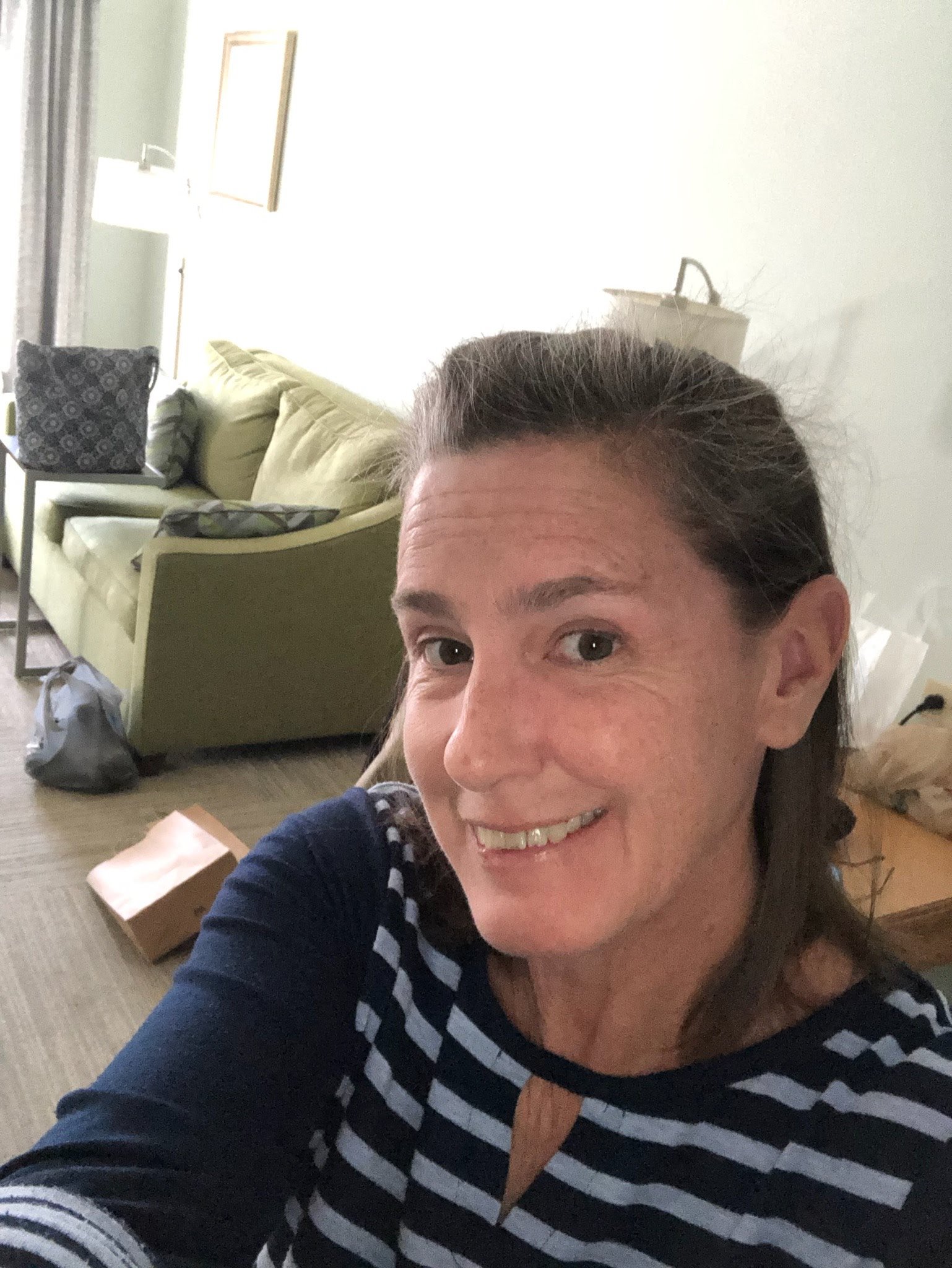25 Years to a Scleroderma Diagnosis
Kristine’s Story
Folia user Kristine shares her journey to a scleroderma diagnosis and how she managers her condition.
Hi Kristine, would you tell us about your autoimmune journey?
In my twenties I had Raynaud’s phenomenon and such severe joint pain that it was hard to move some days. The doctors thought it was carpal tunnel syndrome, but the conservative treatments for that didn’t help. They thought I was having Raynaud’s because I commuted via the train in Chicago in the winter. There were so many things my symptoms could be blamed on.
My mother worked for a rheumatologist at the time and when he heard my story he suggested I make an appointment to see him. He ran blood work and said there were indications that something wasn’t right, but it wasn’t pronounced enough to give me a diagnosis. I kept seeing him, but my symptoms calmed down and all the blood work came back normal. The doctor told me the issues might come back or might not. I got married and had kids, and I had a lot of trouble carrying to term. I didn’t know then that autoimmune conditions could impact fertility.
My daughter was 12 when the symptoms started to come back. I noticed soreness and tiredness. My skin was thickening and would split and nothing ever seemed to clear it up. I thought it was just something that happened to me in the winter. But when the morning came that I couldn’t get down the stairs, my husband told me we would try different doctors until somebody could figure this out.
During that time I was having severe headaches. They ran scans, tried medications, and nothing worked. The headaches calmed down and then I started having horrible GI symptoms.
There was no obvious connection. When you have an autoimmune condition, so many things can be written off as something else. My symptoms weren’t consistent. They would happen for a while then be fine, but I knew in my heart that something was wrong.
My husband was vital in encouraging me to keep advocating and trying.
At this point, with these kinds of symptoms, I was talking to a family doctor. And family doctors just don’t have the training. Scleroderma was maybe one lecture in their entire medical education. They don’t know how to recognize it when it shows up, and they don’t know what to do with this kind of patient. Sometimes you have to educate the doctor. My family doctor said “Sure, I’ll run these tests for you. I’m tired of you complaining and I’ll humor you.” Then my ANA came back very high.
After that I had a really severe flare. I worked a job in the afternoons and I hadn’t been feeling well, but it was only a 4- hour shift so I went. When I arrived at work, I started shaking with chills and my hands wouldn’t work. My boss told me I needed to go home, but I couldn’t drive so my husband picked me up. I called the family doctor and told them it felt like an allergy attack but it wasn’t. They told me to take Benadryl and that there was nothing they could do for me. I was just asking if I should go to the ER or urgent care. Clearly they thought I was being hysterical.
The next day I was still feeling rotten, and I told my family doctor that I wanted a referral to a new rheumatologist ASAP. There are very few in Columbia, SC, and the wait times were 10 months to two years. That’s another part of advocacy and education. In some places there aren’t doctors available, and you need care NOW before everything crashes. My husband was there behind me because the family doctor was his doctor as well. My husband was advocating for me and expressing his frustration that they hadn’t done something more for me up to this point given my health deterioration. That’s when our family doctor finally said that he didn’t have experience with this type of condition and he didn’t know what to do.
How did you find the right rheumatologist?
I had to advocate a lot for myself. I had one rheumatologist who told me that nothing was wrong with me, and I should stop wasting his time.
It took me four tries to find a rheumatologist who would listen to me and run the tests I needed.
Finally, I found a rheumatologist who helped me. By the time I got to him, I could barely walk. He settled on the diagnosis and took the time to explain to me what was happening. I was formally diagnosed 25 years after the first contact with a rheumatologist. That is sadly very normal. The rheumatologist who diagnosed me retired during COVID, and he referred me to my current amazing doctor, Dr. Richard Silver. He’s on the board of the Scleroderma Foundation, and the Medical University of South Carolina is a Scleroderma Center of Excellence. There is a whole team who will battle with the insurance company when you’re trying to get something approved. There is also access to drug trials and research there.
What was it like figuring out treatment options once you finally got the diagnosis?
My rheumatologist explained to me the medications available and that we would need to explore by trial and error until something worked. It took me three or four medications before I ended up on mycophenelate mofetil, a chemotherapy drug. With one drug, I was giving myself injections a couple times a week. One made me so nauseous I couldn’t keep food down.
That was a very wearing part of the autoimmune journey. I felt like I was somebody’s science project.
With only about 300,000 people with scleroderma, there’s not a lot of research on medications yet. I was at the mercy of “this works for some people”, and I went through a lot of trial and error.
That’s challenging not just on your body but also when dealing with insurance. My doctor would say, “This drug works for rheumatoid arthritis, and I think it might help with your scleroderma.” Then my insurance company would say no because that’s considered off-label use.
Being at MUSC with their team there to help is huge. Of all the drugs I take there’s only one that’s approved for use with scleroderma. I take that drug to tame my immune system so it’s not constantly attacking my body. That’s the only one that’s approved. My team has to be savvy when they write orders for prescriptions so that insurance will pay for it. It can be frustrating to hear about new developments for other diseases but the smaller or rare autoimmune diseases there is little being done.
Would you share a little about the mental burden of living with a condition?
Before being diagnosed I was upset and panicked because I didn’t know what was going on. I couldn’t function like I was used to functioning. When I did finally get my diagnosis, I started trying to figure out ways that I could manage or control what was going on. I think that’s a very common thought when you first get diagnosed. What can I do to make myself better? What can I do to learn to manage my condition? It was hard because there was a part of me that didn’t want to admit I would have to drag this thing around for the rest of my life.
It can be a really lonely road, especially at the beginning. I’ve had friends who dealt with depression so I recognized that I was depressed, and I sought support. I had to make peace with the diagnosis. I have a fighting spirit so at first I thought, “I don’t need therapy.” But I have a wonderful therapist who’s been with me over a year. There’s definitely a grieving process around the vision of what you think your life would be to what it has become. I credit my therapist for making me talk through things.I’m coming out of the initial phase of “I’ve been diagnosed, I have physical limitations, and this is so unfair.” I’m coming around the corner and wondering what I can do to help other people. I’m ready to talk about it now.
That’s a place where Folia has come in. Here’s a team of people who are supporting me and helping me to monitor what’s going on. A lot of that support is few and far between.
Would you tell us about using Folia to manage your scleroderma?
In systemic scleroderma, it can cause hardened skin on the surface. But it can also affect the smooth muscles in your gut, leading to dysmotility, GERD, or other complications in your lungs, heart, or glands. Because nothing’s moving the way it should and the muscle is compromised by scar tissue, you have recurrent bouts of diarrhea or constipation or both. In an effort to quantify my GI issues, the tracking in Folia has been great. I shared my Folia data with my doctor and she said, “Ok, it’s time to do a FODMAP elimination diet and gradually add things back in to see if any foods are triggering this.”
As great as my rheumatologist is, he sees me every 90-120 days. He has a lot of questions about my symptoms between clinic visits.
Having Folia as a tool is wonderful because my experience over the last few months is right there. During appointments I’m trying to be calm and hold it together and get through the appointment. When you have a chronic disease you want to hold control. Folia has been a game changer for me.
What advice do you have for others on this journey?
I was relieved when I finally had a diagnosis. Then I knew what I was fighting, and I could tailor what I was doing to manage my condition better. It’s hard to stay positive through a diagnosis, but it’s important. Instead of passively letting the disease problems hit you, you can work toward managing the condition proactively and positively. For example, I learned that it’s not just cold that causes Raynaud’s. I was walking around with mittens in June! Raynaud’s can also be aggravated by stress because of the fight or flight response. Once I learned that, my mindset was, what can I do to lower my stress? My version of “stay positive” is to find the things that I have control over and manage them.
The other piece of advice I have would be to share your diagnosis with people who are safe when you’re ready. I wasn’t ashamed, but it felt awkward trying to explain what was going on physically. I didn’t want it to sound like a pity party. However, advocacy and education don’t grow when you hide your condition. Learning how to talk to other people about the scleroderma was a milestone for me. My husband and I have a close group of college friends. We’ve been together through it all. They knew I wasn’t 100%, but I couldn't bring myself to explain why because their empathy would have turned me into a blubbering mess. But we finally told them in a low-key way. The next time we were all together for a weekend, I knew I could tell them I was tired and they would accept that. There wasn’t overdone sympathy from them. Finding your sources of support and not being ashamed or worried to talk about what’s going on with you is huge.

